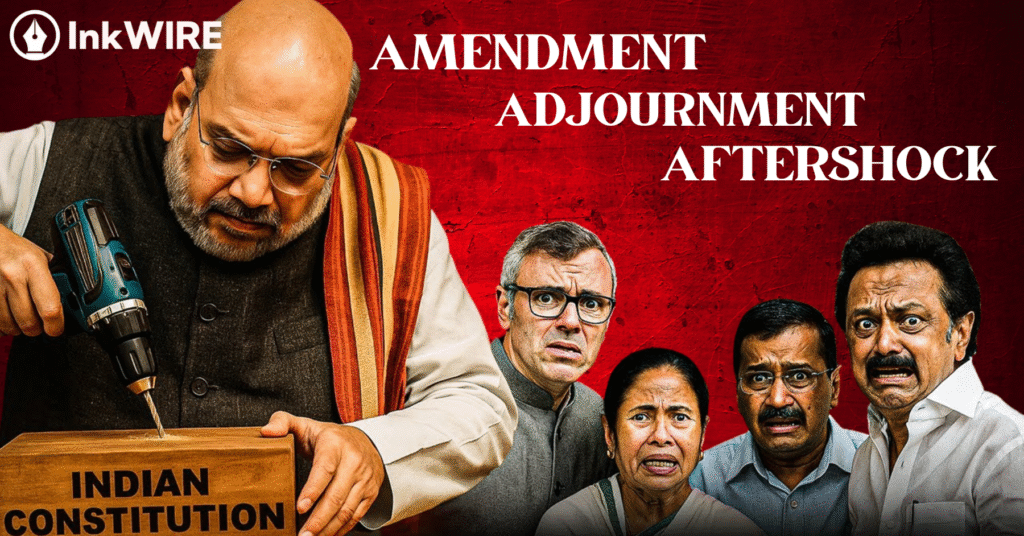PM, CMs, and Ministers face removal triggers; chaos forces swift referral

“Parliament must argue with facts, not fists.”
Anti-corruption reform collided with raw politics as the Lok Sabha convulsed over the Constitution (130th Amendment) Bill, 2025. Detention for 30 days would trigger removal from office for the Prime Minister, Chief Ministers, and Ministers. Supporters promised integrity and evidence protection. Opponents warned about due process, misuse, and federal instability. Consequently, pandemonium replaced persuasion while the Bill still advanced.
The Speaker allowed introduction by voice vote despite uproar. Torn papers flew, and benches surged toward confrontation. Marshals ringed the Well as slogans drowned discussion. Then, the House referred the amendment to a joint committee alongside two related Bills. A quick report was sought before the next session for scrutiny and debate.
What the Bill actually proposes
- Coverage: Prime Minister, Chief Ministers, Union Ministers, State Ministers.
- Trigger: Continuous detention for 30 days in scheduled corruption or serious offences.
- Effect: Removal from office during custody under a defined process.
- Rationale: Prevent interference with probes and preserve public confidence.
Therefore, the Bill ties high office to unimpaired liberty during active custody. It claims hygiene over vendetta, process over optics, and probity over convenience.
Why the House erupted
- Detention is not guilt; custody can precede charges.
- Agencies could time arrests to topple executives.
- Opposition-ruled states fear asymmetric pressure.
- Late circulation inflamed suspicion and resistance.
Tempers spiked when a senior leader tore a copy in the Well. Treasury and TMC benches moved close as taunts escalated. The Speaker ordered adjournments and admonished members repeatedly. After reconvening, the voice vote cleared introduction, and referral followed.
Clarity on who removes whom
- Prime Minister: Presidential order after judicial confirmation and the amendment’s advice chain.
- Chief Minister: Governor’s order after court confirmation under defined timelines.
- Union Minister: Presidential order after verification and prescribed advice.
- State Minister: Governor’s order under the same verification-and-advice logic.
Accordingly, the amendment must codify verification, advice, signatory, and clocks for each office. Ambiguity invites crisis during sensitive moments.
Drafting precision decides credibility
Words must meet constitutional standards with clarity. Vague phrases enable discretion and confusion. Clear schedules, tight definitions, and review lanes de-risk enforcement. Moreover, transparency builds legitimacy with citizens and markets.
Key drafting questions that need answers:
- Which exact statutes define qualifying offences?
- Who confirms detention, and within what hours?
- How long can removal last before automatic review?
- What triggers reinstatement if custody ends?
- Will reasoned orders be published with justified redactions?
Ethics, rights, and real-world incentives
Citizens want clean governance and fair process together. Active custody strains ministries and investigations. Yet detention without conviction should not become a political lever. Therefore, safeguards must walk with integrity to avoid weaponization.
Agencies respond to incentives and visibility. High-profile custody can dominate airtime. It may solve little without system reform. Predictable rules change incentives. Precision and speed curb theatrics and promote outcomes.
Credible safeguards that prevent misuse
- Tight offence schedule: Limit triggers to listed corruption and grave offences.
- Judicial confirmation: Require court validation of qualifying detention within 48–72 hours.
- Time-bound removal: Make removal temporary with automatic periodic review.
- Fast appeals: Create an expedited bench with firm deadlines.
- Transparent orders: Publish reasons; redact only where strictly necessary.
- Symmetry: Apply identical standards across Union and States.
- Abuse penalties: Sanction malicious or reversed invocations.
- Reporting: Table quarterly dashboards on triggers, reversals, and timelines.
These guardrails protect investigations and liberty. They deter performative arrests and reputational harm if cases collapse. They also anchor trust through visible accountability.
Federalism, stability, and policy continuity
Opposition-ruled states fear asymmetric application. Symmetry reduces that risk and stabilizes federal balance. Markets prefer stable cabinets with credible anti-graft rules. Budgets and reforms hate volatility. Thus, time-boxed reviews and transparent logs steady governance.
Predictable clocks help ministries plan transitions. Clear appellate routes reduce rumor. Open dashboards allow citizens to audit power. Confidence grows when rules move faster than outrage.
Parliamentary conduct is policy in motion
Disorder hides weak clauses and smothers strong ones. Young citizens watch and learn norms from the floor. Procedure, persuasion, and evidence should lead every session. Calibrated penalties can deter repeat disruptions while protecting minority speech. Consistent rulings from the Chair reinforce fairness across benches.
Therefore, conduct reforms matter for law quality. Debate must recover pace, clarity, and civility. The House should model reason, not rage, under pressure.
Path to workable consensus
- Convene a cross-party group with jurists and former CAG officials.
- Publish a green paper with model clauses and stress-tested scenarios.
- Invite time-boxed public comments on safeguards and timelines.
- Add a one-year sunset with quarterly audits and publication.
- Table a full impact note before final passage.
This path converts outrage into architecture. It creates rules that endure courts and elections. Reform then stands on process and trust, not noise.
What citizens should track next
- Are qualifying offences listed narrowly and clearly?
- Is court confirmation mandatory before removal?
- How long can removal last before automatic review?
- Will each action include a public, reasoned order?
- Do symmetrical standards apply across Union and States?
These signals reveal intent and integrity. Clean governance and fair process must advance together. Voters can then judge on facts, not fury.
Quotes from the floor and the moment
“Clean power demands strong rules, clear reasons, and short leashes.”
“Debate is strength; disorder is decay.”
“Punish graft, not dissent.”
Editorial lens: Strength with restraint
Integrity rules protect the public purse and the Republic. Safeguards protect liberty and legitimacy. Tie removal to scheduled offences with tight drafting. Demand rapid court checks and hard review clocks. Publish reasons. Audit every trigger. Build a fast appeals lane that moves on time.
Therefore, the amendment should become a shield for citizens, not a sword for politics. The committee must write with care, humility, and transparency. India needs a standard that deters corruption, withstands pressure, and respects rights.
Conclusion: Turn chaos into a durable standard
The 30-day detention rule now sits with the joint committee. The House owes citizens clarity, symmetry, and speed. Draft the chain for PM, CMs, and Ministers precisely. Install safeguards that prevent misuse and encourage trust. Replace a day of torn papers with a law that elevates governance.





